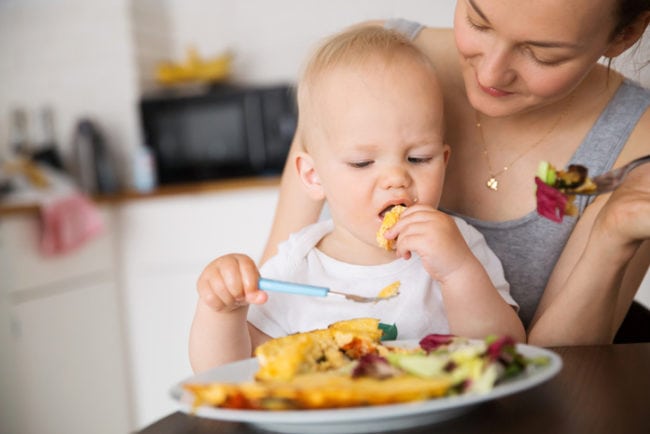Ah, the time has come. You are about to have a new eater in your family and this is an exciting moment. Now you get to see their face light up when they taste something they love! In addition to their new zest for pears and peas, this is the beginning of the road to cultivate your foodie extraordinaire! There is so much to explore! Apart from choosing the different ways you can nourish your child, you will also start developing the palate of your little one. And sometimes, like everything in parenting, this does not go as planned.
We are here to help! There are ways you can assist your new eater of solids to become a toddler who enjoys food, who will eventually turn into a preschooler who loves food and so on. From pureeing to baby-led weaning, there are ways to help create an adventurous eater.

iStock
Baby Led Weaning
Most children begin reaching for food when they are six months old. This is the pediatrician recommended age to start your child on solids. To our friends across the pond, “weaning” means to start adding foods to your child’s diet once they are six months. Here in the U.S. it means to stop breastfeeding. The practice of baby led weaning was created in the U.K. so that’s where the name comes from. The food is served extra soft, in a strip or coin shape so that the baby can grab it. It promotes coordination, dexterity and strong chewing. It’s also the beginning of creating healthy eating habits. We chose to do a combo of both purees and BLW which worked very well for our family. To read more on the topic, check out this article.
Consistent Meal Times
Having your meal times at the same time every day is beneficial. “It is so valuable to the developing spirit of children to have one meal together each day as a family,” says Dr. Peter Gorski, assistant professor of pediatrics at Harvard Medical School in Cambridge, Massachusetts. If you know Dad can’t be home for dinner every night but he’s there every day at breakfast, aim to have the entire family sitting around the table, enjoying food together at that time.
Shared Plates
When my daughter was 10 months old, I realized that every time I would eat something, she would want to eat it too. It was automatic and she still does this today. So I began putting her in her highchair with a toy. Then I would sit down with my plate of food. She would instantly reach for my food and make noises like she wanted it. I would place little pieces of what I was eating in front of her and she would devour it. Sometimes I would make jokes saying that the food was mommy’s food and this made her laugh and want it even more. If I had put the same foods in front of her and expected her to eat it, I may have been sorely disappointed.

iStock
Small Portions of Different Foods
As children grow older they become very drawn to the bento box way of eating. It gives them variety and choices and it’s an extremely fun way to have a meal. I’m not saying you have to go all out and make hard boiled eggs into panda bears but dividing the food gives the child a sense of curiosity. Because if you cut up their food and arrange it on a plate or cutting board, they are interested in what different things you have provided. For the three big meals, you can use the plates that divide into different sections. And for snack, we usually do something in the picture above
If At First You Don’t Succeed
Tenacity is extremely important in helping your kids to become good eaters. Sometimes a child needs to be served something 10-15 times before they actually like it. That can actually take years. If your child doesn’t have any sensory issues, just keep serving up those lentils. When my daughter doesn’t care for something right away, I put something she loves in it (ex. pancetta). The first few times she eats the dish she picks what she likes out of it. After I have served it three or four times she usually indulges in the entire thing. Right now we are struggling with tomatoes, our 5-year-old seems to be pretty firm on not liking them and that’s ok too. Pick your battles and remember to start small.
And sometimes…you try all of it and none of it works and it is what it is and everything will be ok. Welcome to parenting.

